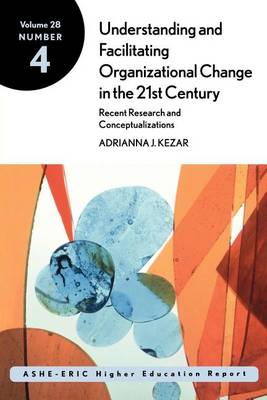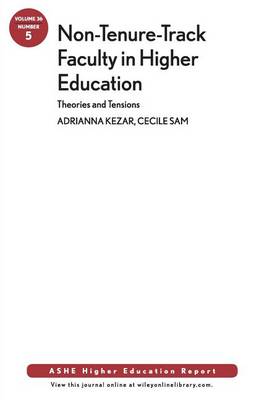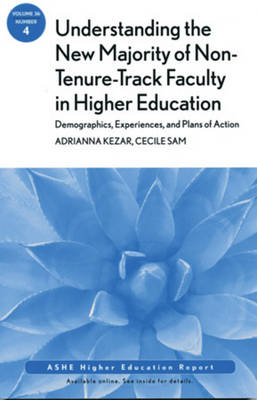J-B ASHE Higher Education Report Series (AEHE)
2 primary works • 3 total works
Book 156
Understanding and Facilitating Organizational Change in the 21st Century: Recent Research and Conceptualizations
by Adrianna Kezar
Published 26 September 2001
There is a widespread discontent with the quality of education and levels of college student achievement, particularly for undergraduates preparing for the professions. This report examines the educational challenges in preparing professionals, reviews the specific types of curriculum innovations that faculty and administrators have created or significantly revised to strengthen college graduates' abilities, and focuses on the societal changes and expectations produced by the acceleration in technology.
Book 174
Non–Tenure–Track Faculty in Higher Education: Theories and Tensions
by Adrianna Kezar and Cecile Sam
Published 15 February 2011
American faculty are changing. Approximately 65 percent of all faculty now being appointed are nontenure track. Despite these changes, many higher education institutions still operate as though tenure-track faculty are the norm and non-tenure-track faculty are a supplementary workforce. This monograph highlights practical and empirical tensions, reviewing theories and frameworks that have been applied to the study of non-tenure-track faculty in an attempt to better understand their emergence, experience, and outcomes. It also reviews the literature about key tensions that emerge because of the development of this new group of faculty: * Is tenure still relevant and important? * Can tenure-track and non-tenure-track faculty find shared interests to collectively create change? * Can non-tenure-track faculty overcome competition that prevents them from working together meaningfully? * Why is the research on the institutional and student impacts of non-tenure-track faculty so mixed? * Does empirical research address stereotypes about non-tenure-track faculty and how can it be spread more widely to imporve institutional decision making? * What future research is needed to guide policy?
As a guide to the trends and research in non-tenure track faculty, this is an invaluable review for administrators and faculty who want to make better-informed decisions about staffing. This is the fifth issue in the 36th volume of the Jossey-Bass series ASHE Higher Education Report. Each monograph in the series is the definitive analysis of a tough higher education problem, based on thorough research of pertinent literature and institutional experiences. Topics are identified by a national survey. Noted practitioners and scholars are then commissioned to write the reports, with experts providing critical reviews of each manuscript before publication.
As a guide to the trends and research in non-tenure track faculty, this is an invaluable review for administrators and faculty who want to make better-informed decisions about staffing. This is the fifth issue in the 36th volume of the Jossey-Bass series ASHE Higher Education Report. Each monograph in the series is the definitive analysis of a tough higher education problem, based on thorough research of pertinent literature and institutional experiences. Topics are identified by a national survey. Noted practitioners and scholars are then commissioned to write the reports, with experts providing critical reviews of each manuscript before publication.
The American faculty is changing. Approximately 65 percent of all faculty appointments being made are now nontenure track. Despite these changes, many higher education institutions still operate as though tenure-track faculty are the norm and that non-tenure-track faculty are a supplementary workforce. This monograph provides an overview of the literature and research on non-tenure-track faculty. Who are these faculty members? What are their experiences? What does this situation mean for undergraduate instruction and students? What is the role of tenure in higher education? How did higher education attain this majority of non-tenure-track employees? Where does higher education go from here? The research focuses on the demographics of non-tenure-track faculty, differences by discipline and institutional types, historical developments, experiences of non-tenure-track faculty, and the experiences and outcomes of non-tenure-track faculty compared with those of tenured or tenure-track faculty.
Administrators and faculty can make better-informed decisions about staffing if they have some understanding about trends and research and the impact of non-tenure-track faculty on institutional outcomes. This is the fourth issue in the 36th volume of the Jossey-Bass series ASHE Higher Education Report. Each monograph in the series is the definitive analysis of a tough higher education problem, based on thorough research of pertinent literature and institutional experiences. Topics are identified by a national survey. Noted practitioners and scholars are then commissioned to write the reports, with experts providing critical reviews of each manuscript before publication.
Administrators and faculty can make better-informed decisions about staffing if they have some understanding about trends and research and the impact of non-tenure-track faculty on institutional outcomes. This is the fourth issue in the 36th volume of the Jossey-Bass series ASHE Higher Education Report. Each monograph in the series is the definitive analysis of a tough higher education problem, based on thorough research of pertinent literature and institutional experiences. Topics are identified by a national survey. Noted practitioners and scholars are then commissioned to write the reports, with experts providing critical reviews of each manuscript before publication.


